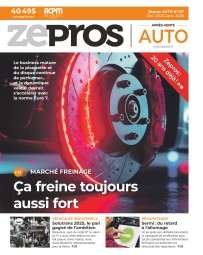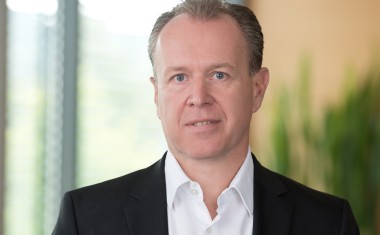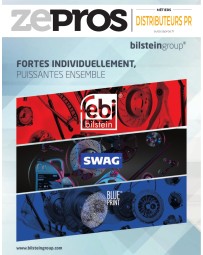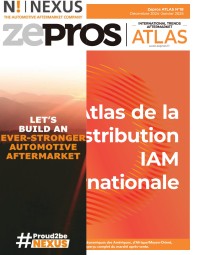
Günter Weber, Groupauto International: “An ITG exists solely to create added value”

The president of Groupauto International since 2023 accrued thirty- years of international experience in OE and IAM parts manufacturing and distribution before joining GAI. This experience has provided Günter with the knowledge and perspective to lead GAI as it adapts to the changing requirements of an ITG.
You headed up Bosch Aftermarket EMEA before you became president of GAUI. How would you describe this ITG in relation to others?
Günter Weber: I was already familiar with the organisation and its environment! The aftermarket is one that I had criss-crossed for years as an equipment manufacturer (see box below) and I have always believed that an International Trading Group exists solely to create added value between its member companies and suppliers. And that's the DNA of Groupauto International! GAUI has settled on a solid plan for the coming years, based on five pillars: maintaining the close links established between our members and our 60 suppliers, continuing to expand our business in line with our needs, recruiting new distributor members with their workshops to increase the density of our network and create a virtuous circle with suppliers, and interconnecting our digital ecosystem (suppliers, distributors, workshops, fleet customers, etc.). Finally, the fifth pillar is the advice we provide in terms of business and opportunities on the ground for our members.
Biography
The former Regional President Europe & Middle East of Bosch Aftermarket took over as President of GAUI in 2023. Günter Weber was also Senior Vice President Marketing and Business Coordination (marketing, sales, communications, digital and strategy for the global automotive supplier's Aftermarket division). During his 30 years in the automotive sector, he has built up a solid international track record: he was President of Bosch India from 2013 to 2016, after having held senior positions in Germany as well as in the United States, South America and the Asia-Pacific region.
How do you highlight these opportunities?
G. W.: Together with our members, we have drawn up an expansion plan for Asia, Latin America and the Middle East. We are jointly drafting a roadmap with the key actions required to complete this business plan. We bring them on board via our regional organisations established on every continent. We are a structured organisation with teams on the ground in Dubai, Türkiye, China, Argentina... That's the difference between us and other ITGs.
Is the support you provide to suppliers more crucial than ever given the tough times they are going through in OE?
G. W.: We are definitely seeing a shift in the market. Original equipment manufacturers are cutting back by closing plants, and most are tightening their strategy around their aftermarket division, which is not affected by the switch to electric vehicles. We are observing this and supporting them. Even so, we must all remain vigilant, because if the OE sector is weakened and shutting plants, what are the long-term consequences for the aftermarket.
Is managing key accounts an essential activity for you?
G. W.: It's a fundamental component of the market! The major accounts we deal with are names such as Ayvens, Arval... (representing several million fleet vehicles), as well as the insurers and other business intermediaries who direct vehicles to our workshops. This is a substantial business, and we have signed partnership agreements between these major accounts, our distributors and their workshops. These agreements are either local (Spain, Italy, the UK, etc.) or regional, covering specific areas such as Europe.
We are a structured organisation with teams on the ground in Dubai, Türkiye, China, Argentina... That's the difference between us and other ITGs.
Does this management imply a higher density of workshops with trained teams?
G. W.: We have added more than 1,000 workshops (at the end of September 2024) to our network of 33,000 garages (Eurogarage, Top Truck and NAPA-branded workshops). Our network and our concept are sufficiently attractive for them to join the repair networks run by our distribution networks. But talent management is important: we need to support distributors so that they can train and upskill their workshops. This is undoubtedly one of the biggest challenges!
Arez some zones more dynamic than others in the aftermarket, from what you can observe?
G. W.: The cursor is moving all the time! Developments differ from region to region, and I don't think there is a universal answer. There's clear growth in the number of vehicles in Latin America, and in Asia with India and China. Many of the equipment manufacturers in these countries are Chinese or Indian. And it's our job as ITGs to open up flows between these suppliers and our distributors. North America and Europe are two more established areas, but the dynamic is driven by the transfer of technology to electrification. As a result, workshops have new needs in terms of parts, equipment and training!
On a global scale, do you have a circular parts offering?
G. W.: We have a wide range of remanufactured products available through our distributors and we are promoting them, but I don't think we're getting the word out fast enough. There is still some resistance from certain distributors. The larger ones are very good at it, like AAG, but it’s less the case among medium-sized ones. We need to work on this, especially as demand is increasing due to the ageing of the vehicle population. We must work intensively on the essential collections before pushing these offers out onto the market.
Do you share the view of AAG chief executive Franck Baduel that the resilience of a business is down to logistical and financial anticipation?
G. W.: Absolutely! We've seen over the last few years that inflation and spiralling prices have pushed the development of certain companies into the doldrums. Now, however, growing technology is shaking things up, from managing combustion engines to electric motors and fuel cells... the changes are constant. Not to mention process digitalisation. All of this requires massive investment in advance, and an unwavering ability to manage complexity.
What’s your view of the convergence happening between OES and the IAM?
G. W.: Vehicle manufacturers are reducing the size of their networks, but jealously guarding access to their vehicle data from the independent aftermarket. It's contradictory. Instead, I see this convergence growing in our networks with the arrival of neo-manufacturers, led by China, looking for these collaborations with the independent market. They have neither the after-sales culture nor the structures with associated services. The question is: which of the 150 Chinese brands present today will still be around tomorrow?
Where do you see the aftermarket in five years’ time?
G. W.: As healthy as ever! We're surfing a dynamic market. Having said that, I can see two phenomena that the ecosystem is going to have to face up to and adapt its propositions to. Firstly, the size of the segment of vehicles over 15 years old raises questions about growth and margins across the entire value chain. With some countries announcing that 40% of their vehicle fleets are already over 15 years old, the needs are necessarily different. Consumers are turning to alternative parts rather than original parts. Secondly, the inevitable growth of the electric vehicle fleet over the next three to five years will overlap with the still massive consumption of parts for internal combustion vehicles. This hybrid situation is a major challenge for distributors - it's a balancing act. In some countries, such as Norway, the electric vehicle market is well established, with a degree of maturity that gives wholesalers a good overview of the parts that are growing and those that are declining in terms of repairs. Other countries - Poland, for example - are still in the early stages of the electric vehicle market, and there's plenty of work ahead.
Key figures
• €35 bn sales
• Established in 114 countries
• 32 regional structures: 2,600 distributors, 4,518 sales outlets
• 34,000 workshops under Eurogarage or Top Truck banner and NAPA branded workshops
• 60 premium suppliers









